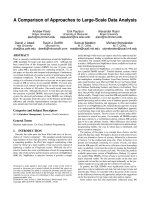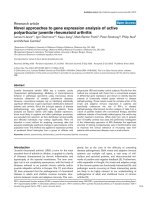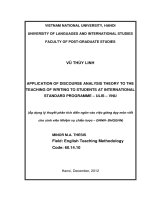Major approaches to discourse analysis
Bạn đang xem bản rút gọn của tài liệu. Xem và tải ngay bản đầy đủ của tài liệu tại đây (452.7 KB, 44 trang )
Major approaches to
discourse analysis
Group members :
Pham Thi Nguyet – K18C
Trần Thị Thu Trang ( 85) – K18C
Trần Thị Thu Trang ( 86) – K18C
Dao Thi Sang – K18C
Do Thi Thu Phuong – K18C
Supervisor : Pr. Dr. Nguyen Hoa
1
1
AN INTRODUCTION TO DIFFERENT MAJOR
APPROACHES TO DA
1.1. From Schiffrin’s view
1.2 From Nguyen Hoa’s view
2
4 MAJOR APPROACHES TO DA
2.1 The pragmatic approach
2.2 The speech act approach
2.3 The interactional and sociolinguistic approach
2.4. Functional vs Formal Paradigms.
3
APPROACHES’ VIEW ON SOME ISSUES ( CENTRAL TO DA)
3.1. On structure and function
3.2. On context
2
From Nguyen Hoa’s
view (2003:79)
Major approaches to DA
Pragmatics
Conversational analysis
Interactional sociolingusitics
Functional vs formal paradigms
Ethnography of communication
3
6 major approaches to DA
s
om n’
Fr fri
hi ew
Sc vi
1
Speech act theory
2
interactional
sociolinguistics
3
pragmatics
4
ethnography of communication
5
Conversational
analysis
6
variation
analysis
4
Pragmatic approach to DA
• Be based primarily
on the philosophical
ideas of H.J.Grice.
Focuses:
meaning, context and
communication of
constructed utterances
in hypothetical context.
5
Why Pragmatics is an approach to DA?
- Pragmatics is most concerned with analyzing speaker
meaning at the level of utterances rather than text. But
utterances situated in context, pragmatics often ends up
including discourse analysis and providing means of
analyzing discourse along the way
6
Meanings in
Pragmatics
Together with the literal meanings or
propositional/ conventional meanings, these
assumptions are the basis to draw specific
inferences about intended meanings or
speaker meanings.
7
Meanings in
Pragmatics
Grice’s pragmatic approach allows
speaker meanings to be relatively free of conventional meanings. What speaker intends to communicate needn’t be related to conventional at all,
and not conventionally attached to the words being used.
•
E.g. Sam is a boy
8
E.g.
Sam is a boy
Expansion
The speaker may intend to create
in the hearer a
recognition of the intention to convey that
proposition about the world, i.e. about Sam’s
identity.
Replacement
9
How do speaker-meanings
arise?
Cooperative Principle ( CP)
10
Gricean pragmatic approach is based
in…
a set of
general principles about
rationally based communicative
conduct
CP
tells S and H
how to organize and use
information offered
in a text, along with
the background knowledge
of the world to convey
more than what is said.
11
Grice’s pragmatics
The cooperative principle:
Four maxims:
1.
Quantity
2.
Quality
3.
Relation
4.
Manner
12
Grice’s pragmatics
1. Quantity
- Make yourself as informative as is required
- Do not make your contribution more informative than
is required
13
Grice’s pragmatics
2. Quality
- Do not say what you believe to be false
- Do not say that for which you lack adequate evidence
14
Grice’s pragmatics
3. Relation: be relevant
4. Manner:
- Be perspicacious
- Avoid obscurity of expression
- Be brief
- Be orderly
15
E.g.
Repetition
A. Smith doesn’t seem to have
a girlfriend these days.
B. He has been paying a lot of visits to New York.
( from Grice 1975: 51)
Expansion
Constructed utterances and constructed context
16
- There is the lack of obvious connection between
two utterances.
- This lack doesn’t prevent readers or A from trying to
interpret B’s utterance.
-B can infer that A has implicated that Smith has a
girlfriend in New York, A is following the maxim of
relation
- Readers or hearers combine literal meaning of
utterances with the assumptions of human rationality
and cooperation.
.
17
Speech Act approach to
DA
18
Why speech act theory is an
approach to DA?
Speech act theory was not first
developed as a means of analyzing
discourse, but some particular issues
in speech act theory lead to discourse
analysis.
19
Speech act theory
Focuses
communicative acts performedExpansion
through speech/ language
Replacement
knowledge of underlying conditions for production and interpretation
of acts through words
20
Function of Language in SA
theory
Language is used not just to describe the world, but to perform a range of other actions that can be indicated in the performance of the
utterance itself.
21
Why language
can perform acts?
Language can do things – can perform acts- because people share constitutive rules that create the acts and that allow them to label utterances as
particular kinds of acts.
22
Speech Act theory
Deal
with
Actual
utterances
less than utterances- types
23
Speech Act theory
Deal
with
the way speakers
and hearers build less than
upon inferences
in talk
the sort of
knowledge that
they can be
presumed to
bring to talk
24
For example:
Do you want a coffee?
This utterance can be identified as:
- a question
- a request
- an offer
.
+ These 3 acts are themselves intertwined. In other words, they are intricately related to one another.
25









